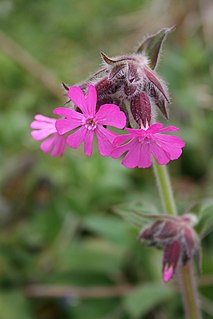
Silene is a genus of flowering plants in the family Caryophyllaceae. Containing nearly 900 species, it is the largest genus in the family. Common names include campion and catchfly. Many Silene species are widely distributed, particularly in the northern hemisphere.
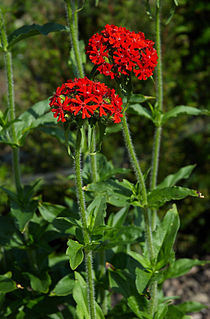
Silene chalcedonica, the Maltese-cross or scarlet lychnis, is a species of flowering plant in the family Caryophyllaceae, native to central and eastern Russia, Kazakhstan, Mongolia and northwestern China. Other common names include flower of Bristol, Jerusalem cross and nonesuch.

Silene flos-cuculi, commonly called ragged-robin, is a perennial herbaceous plant in the family Caryophyllaceae. This species is native to Europe and Asia, where it is found along roads and in wet meadows and pastures. In Britain it has declined in numbers because of modern farming techniques and draining of wet-lands and is no longer common. However, it has become naturalized in parts of the northern United States and eastern Canada.

Silene dioica, known as red campion and red catchfly, is a herbaceous flowering plant in the family Caryophyllaceae, native throughout central, western and northern Europe, and locally in southern Europe. It has been introduced in Iceland, Canada, the US, and Argentina.

Silene nutans is a flowering plant in the genus Silene, most commonly known as Nottingham catchfly.

Silene vulgaris, the bladder campion or maidenstears, is a plant species of the genus Silene of the family Caryophyllaceae. It is native to Europe, where in some parts it is eaten, but is also widespread in North America, where it is a common wildflower in meadows, open woods, and fields.

Gradungula is a monotypic genus of South Pacific large-clawed spiders containing the single species, Gradungula sorenseni. It is only found in New Zealand.
The Catalogue of Life is an online database that provides an index of known species of animals, plants, fungi, and microorganisms. It was created in 2001 as a partnership between the global Species 2000 and the American Integrated Taxonomic Information System. The Catalogue interface is available in twelve languages and is used by research scientists, citizen scientists, educators, and policy makers. The Catalogue is also used by the Biodiversity Heritage Library, the Barcode of Life Data System, Encyclopedia of Life, and the Global Biodiversity Information Facility. The Catalogue currently compiles data from 168 peer-reviewed taxonomic databases that are maintained by specialist institutions around the world. As of June 2021, the Catalogue lists 1,997,284 of the world's 2.2m extant species known to taxonomists on the planet at present time.

Sorensen's leaf-nosed bat is a species of bat in the family Hipposideridae that is endemic to Indonesia.

The Pettalidae are a family of harvestmen with 75 described species in 10 genera. Several undescribed species are known or assumed in some genera.

Thorvald (Thorwald) Julius Sørensen was a Danish botanist and evolutionary biologist.

Silene campanulata is a species of flowering plant in the family Caryophyllaceae known by the common names Red Mountain catchfly and bell catchfly. It may be a synonym of Silene greenei.

Silene dichotoma is a species of flowering plant in the family Caryophyllaceae known by the common name forked catchfly. It is native to Eurasia and it is known in other parts of the temperate world, such as sections of North America, where it is a weed that grows in disturbed habitat. It is an annual herb growing up to 80 centimeters tall. The lance-shaped leaves are up to 8 centimeters long on the lower stem and are smaller farther up. Each flower is encapsulated in an inflated calyx of sepals lined with ten veins. It is open at the tip, revealing five white to red petals, each with two lobes at the tip and sometimes taking a curled form.

Silene conica is a species of flowering plant in the family Caryophyllaceae known by the common names striped corn catchfly and sand catchfly. It grows in dunes and sandy soils and is widespread in Europe and western Asia. It has an annual life history and produces self-compatible hermaphroditic flowers and occasional male-sterile flowers. Like other members of Silene section Conoimorpha, S. conica is readily recognizable based on its bright pink petals and the prominent, parallel veins on its calyx. In contrast to most flowering plants, S. conica appears to have a very rapid rate of mitochondrial mutation, and has the largest mitochondrial genome ever identified.

Silene colorata is a species of plant in the family Caryophyllaceae. It is native to Lebanon and surrounding mediterranean areas.

Silene parryi is a species of plant in the family Caryophyllaceae known by the common name Parry's silene. Its range includes southern British Columbia and Alberta, Canada, south to Oregon and east to Colorado and western Montana, United States. It is most common from 4,000–11,000 feet (1,200–3,400 m) elevation. Silene parryi is a pubescent and glandular perennial herbaceous plant 200–400 mm (8–16 in) tall. The calyx is tubular with ten contrasting nerves, 12–16 mm (0.5–0.6 in) long. It inflates in fruit. The five-lobed flowers are white, sometimes purple or green-tinged.

Silene samojedorum is a flowering plant in the family Caryophyllaceae.
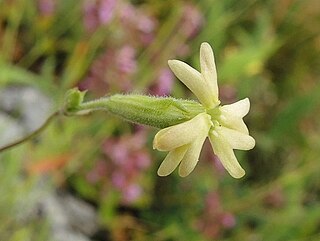
Silene flavescens are flowering plants part of the genus Silene, family Caryophyllaceae. They are widely distributed and are found in the northern hemisphere. They are native to Hungary and the Balkan Peninsula. It is an herbaceous species belonging to the tribe Sileneae
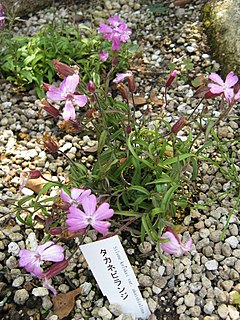
Silene keiskei is a species of flowering plant in the family Caryophyllaceae. The species is native to Japan (Honshu).
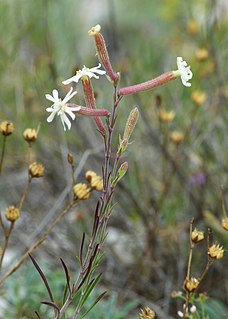
Silene supina is a species of flowering plant in the family Caryophyllaceae.



















